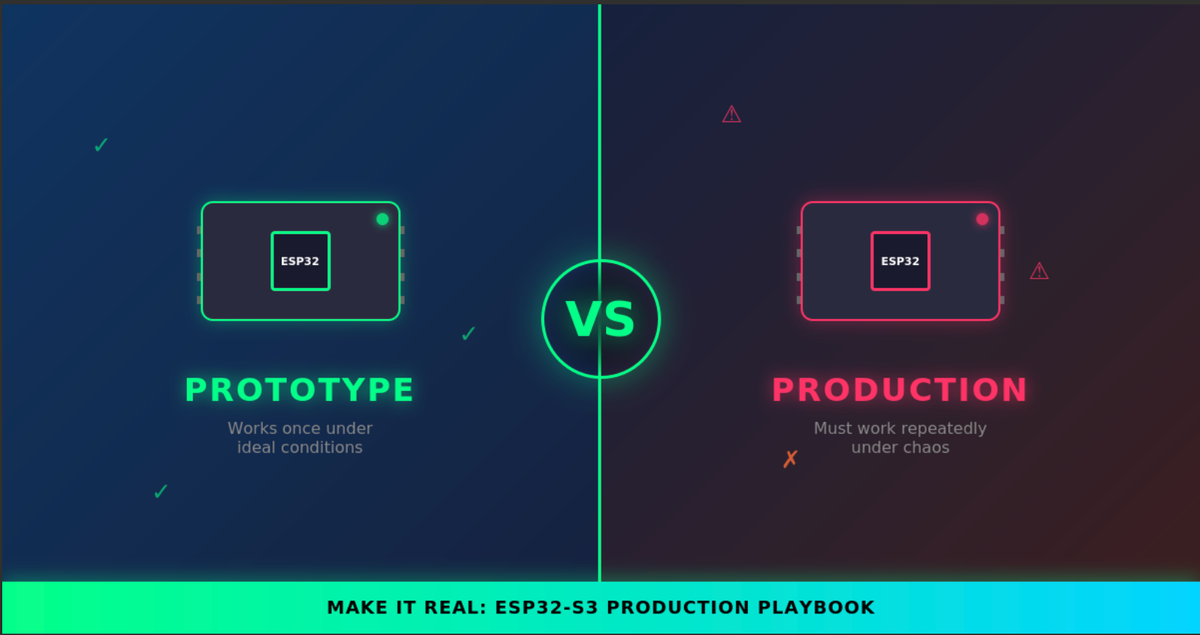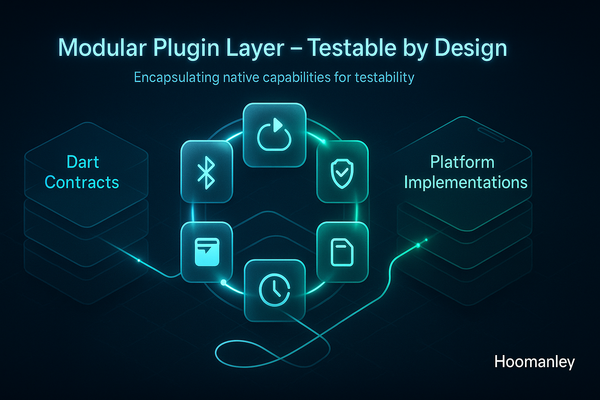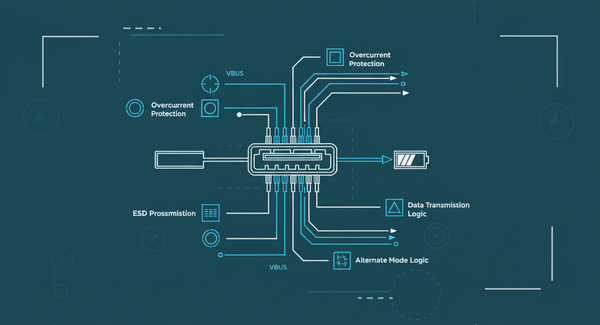Make It Real: ESP32‑S3 Production Playbook

That ESP32-S3 prototype working perfectly on your desk? It'll brick itself in production. Here's the brutal checklist that separates hobbyists from engineers shipping real products.
The Reality Check Nobody Talks About
You've built something magical. Your ESP32-S3 prototype streams 9-axis IMU data flawlessly. The BLE connects every time. Battery lasts for days. You're ready to manufacture 10,000 units.
Then production starts.
Units randomly brick themselves during OTA updates. BLE pairing works... sometimes. Filesystems corrupt when users pull the battery. Your customer support inbox explodes.
What happened?
The brutal truth: A prototype works once under ideal conditions. A product works repeatedly under chaos.
Power cuts mid-write. Dropped BLE connections during handshakes. Filesystem corruption from unexpected resets. Failed OTA updates. Your device needs to survive all of it, every time, or your returns will bankrupt you.
This playbook contains the seven gates that separate working prototypes from shippable products. Skip even one, and you'll discover it the expensive way.
Understanding the Journey: Where You Actually Are
Most hardware teams blow past critical validation stages and pay for it later. Here's the real timeline:
Concept → Feasibility → Prototype → DVT → PVT → Mass Production

The killer zone? Prototype to DVT. This is where "it works!" transforms into "it works 10,000 times in a row."
The Seven Gates: Your Production Survival Guide
Gate 1: Explicit State Machine — The Brain Surgery Your Code Needs
Why it matters: Implicit state management killed more production devices than any other firmware bug.
Random flags scattered everywhere. Timers fighting each other. Race conditions that only appear at 3 AM in the field. This is what happens when you don't have an explicit state machine.
The fix is simple but non-negotiable:
CopyCopy
typedef enum {
STATE_BOOT,
STATE_SELF_TEST,
STATE_IDLE,
STATE_ADVERTISE,
STATE_CONNECTED,
STATE_STREAMING,
STATE_ERROR,
STATE_OTA_UPDATE,
STATE_REBOOT
} device_state_t;
Every state is explicit. Every transition is deterministic. Invalid transitions become impossible. Your device becomes predictable.
Critical checklist:
- Use enums for all states (no magic strings or ad-hoc booleans)
- Define valid state transitions in a table — enforce them religiously
- Log every state change with timestamps (you'll thank yourself during debugging)
- Guard transitions with clear conditions — no wishful thinking
- Enable watchdog timer to catch lock-ups in bad states
The test: Can a junior engineer look at your code and draw the state diagram in 5 minutes? If not, you're not done.
Gate 2: BLE L2CAP Contract — The iOS Handshake That Destroys Products
Why it matters: More products fail in the field from BLE pairing issues than any other single cause. iOS CoreBluetooth is unforgiving about timing.
Here's the handshake sequence that must be perfect:

Miss any step or do them out of order? Your device pairs once, then mysteriously fails on reconnects. Users blame your hardware. Support blames your firmware. Everyone's right.
Non-negotiable checklist:
- Publish L2CAP PSM via GATT characteristic before iOS attempts connection
- Follow the exact handshake sequence (no shortcuts, no "optimizations")
- Use credit-based flow control (initialize with 10 credits on both sides)
- Append CRC16 to every frame for integrity verification
- Stress test: 100+ reconnect cycles — reboots, out-of-range, airplane mode, battery pulls
The reality check: If you haven't tested 100 reconnects, you haven't tested anything.
Gate 3: Journaled Storage — When Users Yank the Battery
Why it matters: Real users don't shutdown gracefully. They pull batteries mid-write. Devices crash. Power cuts happen. Your filesystem needs to survive it all.
Bulletproof storage checklist:
- Mount filesystem early (before any tasks that read/write)
- Implement journal headers every N records (recovery points for interrupted operations)
- Add CRC/checksum to every record written to flash
- Always check free space before writes (handle low-space gracefully)
- Power-cut testing: 100 forced resets during intensive write operations — device must recover every time
The torture test: Pull power during writes 100 times. If even one corrupts, you're not production-ready.
Gate 4: Power Budget Validation — Why Your Battery Claims Are Lies
Why it matters: Datasheet numbers are fantasy. Real-world power consumption will embarrass you if you don't measure it.
The shocking reality:
| Mode | Current Draw | Daily Consumption |
| Deep Sleep | 10-15 µA | 0.3 mAh (negligible) |
| Advertising | 0.5-1 mA | 12-24 mAh |
| Connected Idle | 2-3 mA | 50-70 mAh |
| Streaming | 40-50 mA | 1000+ mAh |
Translation: Your "lasts 3 months" claim becomes "dies in 36 hours" when users actually use it.
Power optimization checklist:
- Measure everything with a real power profiler (not datasheets)
- Enable modem sleep during BLE idle periods
- Replace always-on LEDs with 5% duty cycle blinks (or remove them)
- Duty-cycle sensors — sample at 50 Hz only during motion, otherwise sleep
- Reality-check: Run device through actual usage patterns on real battery, verify claims
The truth bomb: If measured battery life doesn't match your marketing claims, change one of them before production.
Gate 5: Safe OTA Updates — Don't Brick 10,000 Devices at Once
Why it matters: A failed OTA update that bricks devices is a company-ending event. Design for failure from day one.
OTA robustness checklist:
- Dual firmware slots (A/B system) — never overwrite running firmware
- Download resume capability (save progress to NVS, continue after interruption)
- Self-test sequence on first boot after update (verify sensors, connectivity, critical functions)
- Automatic rollback after 3+ watchdog resets (bad firmware can't survive)
- Torture test: Cut power during download, during flash write, during reboot — 10+ different failure points
The survival metric: Device must recover from interrupted OTA 100% of the time. No exceptions.
Gate 6: Security & Identity — The Basics That Protect Your Users
Why it matters: Insecure BLE pairing and missing device IDs will haunt you during support and diagnostics.
What you actually need:
Security:
- LE Secure Connections (modern BLE pairing with ECDH) — not legacy pairing
- Bonding key storage in NVS (no re-pairing every connection)
Identity:
- Unique 128-bit device ID burned at factory (eFUSE or OTP)
- ID exposed via read-only GATT characteristic
- QR code or serial number on device label
Why this matters: When device #7,482 fails in the field, you need to know its firmware version, production batch, and calibration data. A unique ID makes this possible.
Gate 7: Factory Self-Test — Catch Defects Before They Ship
Why it matters: Even perfect firmware can't fix a bad solder joint. Factory test is your last line of defense.
Factory test checklist:
- Automated test sequence covering all critical components
- Test results stored in NVS as bitfield (each bit = one test passed)
- Calibration data saved with version/timestamp for traceability
- Visual indicators for assembly line (green LED = pass, red = fail)
- Device ID printed as QR code on passing units
The quality gate: No test results stored = device refuses to boot. Simple.
The Data Pipeline: From Sensor to Cloud Without Losing a Sample
Understanding how data flows reveals where things break:

Key insights:
- ISR feeds ring buffer (smooths timing jitter)
- TLV format + CRC16 ensures data integrity
- Store to flash if disconnected (no data loss)
- Replay from flash on reconnect
- Backpressure handling prevents mobile app crashes
- Cloud upload when internet available
The Truth Nobody Tells You
Production readiness isn't about perfection. It's about predictability.
Your device will face:
- Power cuts mid-operation
- BLE disconnections during handshakes
- Filesystem corruption from crashes
- Failed OTA updates
- Manufacturing defects
- Users who do unexpected things
The question isn't "will these happen?" The question is: "when they happen, does your device recover?"
Every gate in this playbook exists because someone learned it the hard way. The BLE L2CAP gate? Thousands of devices with intermittent pairing issues. The OTA gate? Bricked units requiring manual recovery. The power budget gate? Angry customers posting 1-star reviews about battery life.
You can learn from their mistakes, or make your own.
Your Move
You have two choices:
Choice 1: Skip gates, ship fast, spend 18 months firefighting field failures, issue recalls, and pray your company survives.
Choice 2: Work through every gate systematically, test beyond the happy path, and ship a device you can predict.
The second choice is harder. It takes longer. It's not as exciting as rushing to production.
But it's the only choice that leads to success.
Get Started Now
- Pick your weakest gate — which one makes you nervous?
- Implement the checklist — don't skip items
- Test until it breaks — then fix it and test again
- Repeat for every gate — no shortcuts
When you can predict how your device behaves even in chaotic conditions, you're ready.
Until then, you're building expensive prototypes that happen to sometimes work.
Now go build something that actually survives production.
Question: Which gate has caused the most failures in your projects? Reply with your horror stories — let's learn from each other's mistakes.




